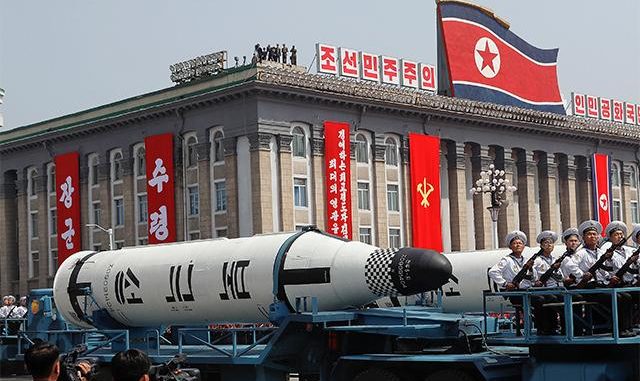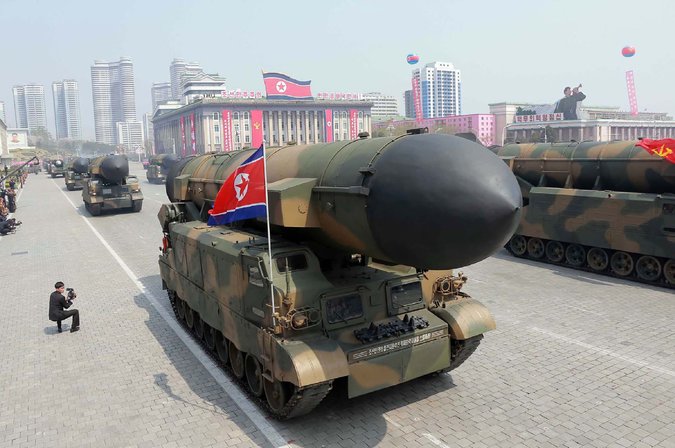
US media continually ignores Chinese fear of poor, hungry, Internet-ignorant North Korean refugees, & spectre of US troops, on its borders. Given this, China has no interest in any “solution” that involves the collapse of the Kim regime.. Perhaps Xi Jinping mentioned these concerns in the “tutorial” he apparently gave Trump at Mar-a-Lago – another bizarre aspect of this situation the US media “tactfully” ignores. Are there no Americans who could have briefed Trump before his meeting with Xi about the basic facts and issues in the China / North Korea relationship? Trump is obviously an ignorant blowhard, who opens his mouth about situations he knows nothing about. But the fact he is “cruising” towards a potential nuclear war in East Asia – and no one in the US seems able to get him to ponder the potential “fallout” from his ill-considered actions – is a damning indictment of a craven US elite whose own lack of knowledge and courage makes them apparently unable to stop him. Here, the star of the Kim Il-sung military parade this weekend in Pyongyang: Pukguksong-2 / KN-15, a solid-fuel rocket that can be launched in minutes – which means North Korea now has missiles that can probably survive any US attack.
All the elements of the North Korean nuclear crisis —
- the relentless drive by Kim Jong-un to assemble an arsenal,
- the propaganda and deception swirling around his progress,
- the hints of a covert war by the US to undermine the effort, rather than be forced into open confrontation —
were on vivid display this past weekend.
There was the parade in Pyongyang’s main square, with wave after wave of missiles atop mobile launchers,
intended to convey a sense that Kim’s program is unstoppable.
Then came another embarrassing setback, a missile test that failed seconds after liftoff,
the same pattern seen in a surprising number of launches since President Barack Obama ordered stepped-up cyber- and electronic-warfare attacks in early 2014.
Finally, there was the test that did not happen, at least yet —
a sixth nuclear explosion. It is primed and ready to go, satellite images show.
What is playing out, said Robert Litwak of the Woodrow Wilson International Center for Scholars, who tracks this potentially deadly interplay, is “the Cuban missile crisis in slow motion.”
But the slow-motion part appears to be speeding up, as President Trump and his clownish aides have made it clear that
the US will no longer tolerate the incremental advances that have moved Kim so close to his goals.
Secretary of State Rex “Empty Suit” Tillerson has said repeatedly that “our policy of strategic patience has ended,”
hardening the American position as Kim makes steady progress toward two primary goals:
shrinking a nuclear weapon to a size that can fit atop a long-range missile,
and developing a hydrogen bomb, with up to a thousand times the power of the Hiroshima-style weapons he has built so far.
That being said, though, the Trump regime obviously has no alternative to “strategic patience.”
While the historical analogiy is, in fact, inaccurate and close-to-useless in actually understanding the current situation, one parallel shines through:
When national ambitions, personal ego and deadly weapons are all in the mix,
the opportunities for miscalculation are many —
see, for example, the Carl Vinson “armada” heading AWAY from Korea, rather than towards it.
So far, Trump has played his hand — militarily, at least — as cautiously as his predecessors:
A series of Situation Room meetings has come to the predictable conclusion that
while the US can be more aggressive, it should stop just short of confronting the North so frontally
that it risks rekindling the Korean War, nearly 64 years after it came to an uneasy armistice.
Still, the current standoff has grown only more volatile.
It pits a new president’s vow never to allow North Korea to put American cities at risk — “It won’t happen!” he said on Twitter on Jan. 2 —
against a young, insecure North Korean leader who sees that capability as his family regime’s only guarantee of survival.
Trump is clearly new to this kind of dynamic, as he implicitly acknowledged when he volunteered
that Xi Jinping, China’s president, had given him what amounted to a compressed seminar in Chinese-North Korean relations.
He emerged surprised that Beijing did not have the kind of absolute control over its impoverished neighbor that he insisted it did last year.
“After listening for 10 minutes, I realized it’s not so easy,” he said.
“It’s not what you would think.”
Trump’s national security adviser, Lt. Gen. H. R. McMaster, gave voice to the difficult balancing act on North Korea on Sunday.
General McMaster, himself a military historian, said on ABC’s “This Week” that while the president had not ruled out any option,
it was time for the US “to take action, short of armed conflict, so we can avoid the worst” in dealing with “this unpredictable regime.”
Translation: Pre-emptive strikes are off the table, at least for now.
The fact that Kim did not conduct a nuclear test over the weekend —
timed to the anniversary of the birth of his grandfather, the founder of the country and its nuclear program —
may indicate that Xi has given him pause.
In the White House’s telling, Xi is responding to pressure by Trump to threaten a cutoff of the North’s financial links and energy supplies — its twin lifelines as a state.
Ballistic missiles were paraded through Pyongyang, North Korea’s capital, on Saturday as part of the celebration of the 105th anniversary of the birth of Kim Il-sung, the country’s founder.
“Why would I call China a currency manipulator when they are working with us on the North Korean problem?” Trump asked in a Twitter post on Sunday morning,
making it clear that everything, including the trade issues he vowed to solve as a candidate, could be a bargaining chip when it comes to defanging the North.
The North is trying to create the sense that it is too late for any such defanging — that it has reached a tipping point in its nuclear push.
That is why Kim stood for hours as so many missiles rolled by on Saturday,
carried on portable launch vehicles that can be hidden in hundreds of tunnels bored into North Korean mountains.
For all the talk of an eventual intercontinental missile that can reach the United States,
one of the stars of the show was a missile of lesser range — the Pukguksong-2, also known as the KN-15.
It is a solid-fuel rocket that can be launched in minutes, unlike liquid-fueled missiles, which take hours of preparation.
That means they are far less vulnerable to a pre-emptive strike from an American missile launched from a base in Japan
or from a carrier strike group like the one Trump has — supposedly — put off the Korean coast.
The KN-15 was successfully tested in February.
On Saturday, it was paraded in public for the first time, like a conquering hero fresh from a moon landing.
“The big takeaway is that they’re taking this seriously,” said Jeffrey Lewis, a North Korea specialist at the Middlebury Institute for International Studies at Monterey, in California.
“They’re trying to develop operational systems that might actually survive on the ground,”
perhaps even enduring blows meant to leave them crippled or destroyed.
But Kim’s otherwise triumphant day took a bad turn when the missile test failed.
North Korea used to be pretty successful at launching missiles,
so much so that its missiles were sold around the world. Then its launches started failing, suggesting the presence of a hidden Washington hand.
Its big setbacks have revolved around the most threatening missile it has so far flight-tested, known as the Musudan.
Last year, it had a failure rate of 88 percent.
Kim was reported to have ordered an investigation into the possibility of foreign sabotage, and the missile has remained unseen since.
Asked on Fox News on Sunday whether the United States had played any role in the latest missile failure,
K. T. McFarland, General McMaster’s departing deputy, said, “You know we can’t talk about that.”
Most likely, no one knows for sure, but the ambiguity feeds North Korea’s paranoia, intelligence experts say.
Although such efforts buy time; they are not solutions.
Equally worrisome to Washington officials and private analysts is the North’s steady progress over a decade
in developing nuclear warheads that are small enough to fit atop long-range missiles.
By definition, the atomic work appears to be far less open to prying eyes and foreign sabotage.
The explosive nuclear tests take place in tunnels dug deep beneath a rugged mountain.
“They’ve done five tests in 10 years,” said Siegfried S. Hecker, a Stanford professor
who once directed the Los Alamos weapons laboratory in New Mexico, a birthplace of the atomic bomb.
“You can learn a lot in that time.”
Tempting as the analogies to Cuba may be, Kim is probably thinking of another nuclear negotiation — with Libya, in 2003.
Its leader, Col. Muammar el-Qaddafi, agreed to give up his nascent nuclear program in return for promises from the West of economic integration and acceptance.
It never really happened.
And as soon as Libya’s populace turned against the dictator during the Arab Spring, the US and its European and Arab allies drove him from power.
Ultimately, he was pulled out of a ditch and shot.
Periodically, the North Koreans write about that experience,
noting what a sap Colonel Qaddafi was to give up the nuclear program that might have saved him.
Kim Jong-un, it appears, is not planning to make the same mistake.
Source: A ‘Cuban Missile Crisis in Slow Motion’ in North Korea – The New York Times
